Imagine your rooftop covered with solar panels coated with pictures of you that generate electricity. It’s now possible (but whether it’s desirable is a completely different matter).
Printable solar cells have been around for quite a while and Australian researchers were among the first in the world to explore their potential. Solar cells that can be printed have some advantages over conventional solar panel production technology, including cheaper mass production and flexibility.
While their efficiency is significantly less than the solar panels we’re more familiar with, ongoing research is occurring to address this; with view to perhaps entire buildings being wrapped in these cells.
Meanwhile, others have been busy developing very different forms of printable solar cells.
Researchers at Aalto University in Greater Helsinki, Finland, wanted to take the technology in another direction and determine if any picture or text could be inkjet-printed as a solar cell.

Obviously, they’ve been successful.
According to postdoctoral researcher Ghufran Hashmi, the cells they’ve created are as efficient and durable as conventional printed solar cells. Their creations have also endured more than a thousand hours of continual light and heat stress without any signs of performance degradation.
The photovoltaic dye can be printed to a shape based on an image file, and the darkness and transparency of various elements of an image can be adjusted accurately.
The biggest challenge in developing their system was determining the most suitable solvent for the dye and the correct jetting parameters required in order to provide precise and uniform print quality
The development presents new possibilities for decorative product- and building-integrated solar cells, but it appears residential rooftops adorned with selfies aren’t exactly what the team have in mind.
“For example, installed on a sufficiently low-power electrical device, this kind of solar cell could be part of its visual design, and at the same time produce energy for its needs,” says Janne Halme.
The Aalto University’s team’s research was supported with funding from Academy of Finland and the SELECT+ Erasmus Mundus Joint Doctoral Programme of the European Union.
Their research has been detailed in a paper “Dye-sensitized solar cells with inkjet-printed dyes” and recently published in the journal Energy & Environmental Science.












































